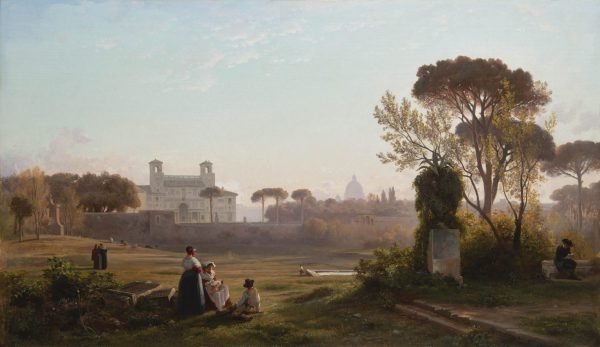View of the Villa Medici in Rome, ca. 1864
Oil on canvas, H. 0.52 m; W. 0.91 m
Signed and located lower right: A Benouville Rome.
Provenance: Private collection, France.
It’s Perfectly Clear
Achille Benouville’s fresh sensitivity was combined with an elegant style and skilful construction of space. With his great feeling for the transparency of air, his art is both unusual and seductive.
This huge garden planted with pine trees, cypresses and green oaks on the Pincio hill in Rome belongs to the Villa Medici, the main façade of which is visible here. This palace belonged to the Medici family from the 16th to the 18th century. In 1803, when Napoleon Bonaparte transferred the French Academy in Rome there, the villa and its gardens were in a sad state and had to be restored to host the winners of the Rome prize who are still based there today.
Many Voyages
Achille Benouville (1815-1891) was trained with his younger brother, Léon (1821-1859) by Léon Cogniet (1794-1880), a defender of Romanticism, and by François Édouard Picot (1786-1868), a representative of the Post-Davidian movement. While continuing his training in Paris, he travelled on several occasions to the Franche-Comté, Switzerland and Italy. In 1843 and 1844, he shared his studio in Rome with Corot. Benouville exhibited at the Salon for the first time in 1834 and continued to show there regularly until his death. In 1863, he won a first class medal and was made a Chevalier of the Légion d’honneur.
Far from Trends
In 1845, the two brothers won the Rome Prize, Léon for history painting, and Achille for historical landscape. The time spent at the Villa Medici was fundamental for Achille’s development and at the end of his stay in 1851, while his brother returned to France, he settled in Rome, marrying a French woman who lived there. About ten years later, his wife abandoned him with their three children who later moved in with their maternal grandmother. The long period spent in Rome, until 1871, had a major effect on his work. He remained distant from developments in French landscape art between 1850 and 1871, both the Realist movement that developed with Courbet and the more rustic one that appeared around Barbizon. He became interested in Italian painting, but transposed into slightly stylized landscapes in which modernity comes forth in the delicate modulation of light. Benouville, whose compositions reveal thorough knowledge of perspective and space, then joined the third generation of Neo-Classical artists, with Paul Flandrin.
Skilled landscapes
The many drawings made in situ during his trips around France and Italy show his fondness for the study of nature for its own sake. This interest is tempered by great familiarity with, and a subtle assimilation of, classical Italian painting. Benouville’s work shows a high standard, great purity of execution, a lively and spontaneous style with an elegant touch and subtle modelling. His light is delicate and he shows a refined sense of shades that are rich and modulated. Benouville’s originality lies especially in his exceptional intuition for the transparency of air, which is especially clear with the bright sky of our painting. While being close to Caruelle d’Aligny and especially the major historical landscapes of Corot, Benouville attracts us with his sensitivity to fresh air.
